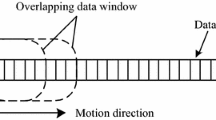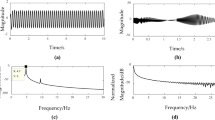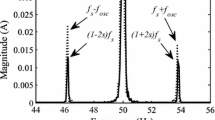Abstract
This paper presents a combination of normalized least mean square (NLMS) filter and Hilbert envelope analysis method to detect the broken rotor bars of a squirrel-cage induction motor. Broken rotor bars are one of the most common fault types that may be seen in induction motors. Rotor faults are reflected in the stator current of the motor as side-band harmonics. Most of the previous works utilize motor current signature analysis using spectral methods to determine required features for detecting motor faults. It may be difficult to detect the faults from stator current when the motor is lightly loaded under noisy conditions. In this study, Hilbert envelope analysis method is used along with an NLMS filter to process the stator current of an induction motor to detect the broken rotor bars. The proposed method is verified experimentally (under 25, 50, and 100 % loading conditions). The results of the recommended method are compared with the results of Fast Fourier Transform (FFT) analysis performed on the stator current of the same motor under the same conditions. The results show that the recommended method gives a more accurate solution compared with the results of FFT method.
























Similar content being viewed by others
References
Gunal S, Ece DG, Gerek ÖN (2009) Induction machine condition monitoring using notch-filtered motor current. Mech Syst Signal Process 23:2658–2670
Nandi S, Toliyat HA, Li X (2005) Condition monitoring and fault diagnosis of electrical motors–a review. IEEE Trans Energy Convers 20(4):719–729
Basak D, Tiwari A, Das SP (2006) Fault diagnosis and condition monitoring of electrical machines–a review. In: ICIT 2006, IEEE international conference on industrial technology
Benbouzid MH (2000) A review of induction motors signature analysis as a medium for faults detection. IEEE Trans Ind Electron 47(5):984–993
Bouchikhi EHE, Choqueuse V, Charpentier JF (2012) Induction machine fault detection enhancement using a stator current high resolution spectrum. In: IECON 2012, Montreal, pp 3913–3918
Bellini A, Filippetti F, Tassoni C, Capolino G (2008) Advances in diagnostic techniques for induction machines. IEEE Trans Ind Electron 55(12):4109–4126
Kia SH, Henao H, Capolino GA (2007) Digital signal processing for induction machines diagnosis–a review. In: The 33rd annual conference of the IEEE industrial electronics society (IECON), November, Taipei, Taiwan, pp 5–8
Mehala N, Dahiya R (2009) Condition monitoring methods, failure identification and analysis for induction machines. Int J Circuits Syst Signal Process 3(1):10–17
Tavner PJ (2008) Review of condition monitoring of rotating electrical machines. IEEE Electr Power Appl 2(4):215–247
Baccarini LMR, Menezes BR, Caminhas WM (2010) Fault induction dynamic model, suitable for computer simulation: simulation results and experimental validation. Mech Syst Signal Process 24:300–311
Xu B, Sun L, Xu L (2013) Improvement of the Hilbert method via ESPRIT for detecting rotor fault in induction motors at low slip. IEEE Trans Energy Convers 28(1):225–233
Tiryaki S, Hatun M, Koçal O (2008) A new adaptive filtering method: hybrid GS-NLMS algorithm. Uludag Univ J Fac Eng Archit 13(2):85–97
Chinaboina R, Ramkiran DS, Khan H, Usha M, Madhav BTP, Sirinivas KP, Ganesh GV (2011) Adaptive algorithms for acoustic echo cancellation in speech processing. IJRRAS 7(1):38–42
Jimenez GA, Munoz AO, Duarte-Mermoud MA (2007) Fault detection in induction motors using Hilbert and wavelet transforms. Springer Electr Eng 89:205–220
Qin Y, Liu Q (2011) On-line detection of rotor bar breaking based on band-pass filter and Hilbert envelope analysis. In: Power engineering and automation conference (PEAM), 2011 IEEE, pp 331–334
Kara Ö (2011) Asenkron motorlarda rotor kırıkları analizi ve modellenmesi. Master Thesis, Dumlupınar University, Turkey, pp 44–45
Pezzani C, Donolo P, Bossio G, Donolo M, Guzman A, Zocholl SE (2014) Detecting broken rotor bars with zero-setting protection. IEEE Trans Ind Appl 50(2):1373–1384
Shi P, Chen Z, Vagapov Y, Zouaoui Z (2014) A new diagnosis of broken rotor bar fault extent in three phase squirrel cage induction motor. Mech Syst Signal Process 42:388–403
Maruthi GS, Hegde V (2013) An experimental investigation on broken rotor bar in three phase induction motor by vibration signature analysis using MEMS acceloremeter. Int J Emerg Technol Adv Eng 3(4):357–363
Acknowledgments
This research is partially funded by Dumlupinar University Research Fund (DPÜ-BAP 2012-29). The authors acknowledge the support of Dr. Dogan G. ECE and Dr. Radoslaw ZIMROZ during the conduction of this research.
Author information
Authors and Affiliations
Corresponding author
Rights and permissions
About this article
Cite this article
Unsal, A., Kabul, A. Detection of the broken rotor bars of squirrel-cage induction motors based on normalized least mean square filter and Hilbert envelope analysis. Electr Eng 98, 245–256 (2016). https://doi.org/10.1007/s00202-016-0366-5
Received:
Accepted:
Published:
Issue Date:
DOI: https://doi.org/10.1007/s00202-016-0366-5




